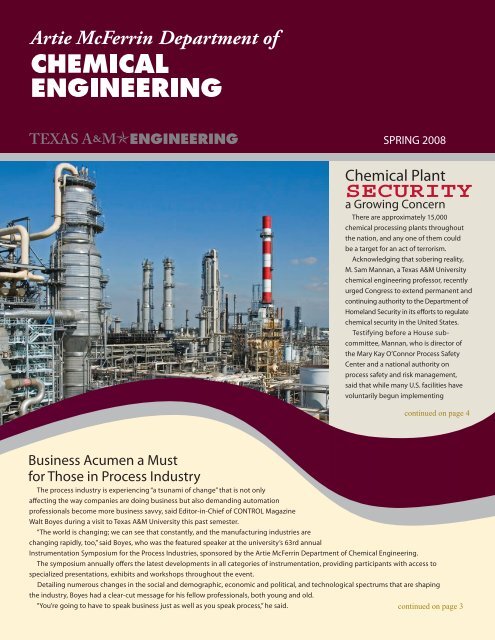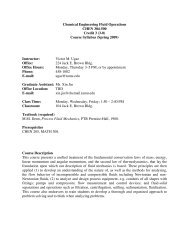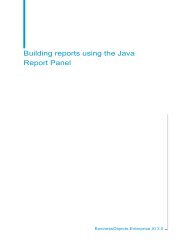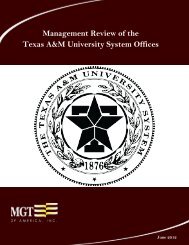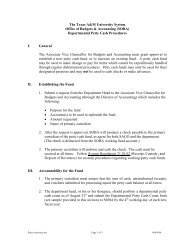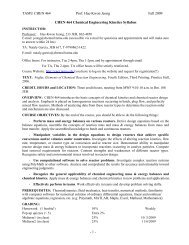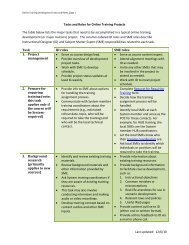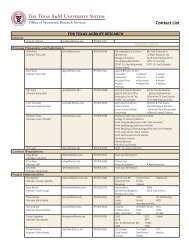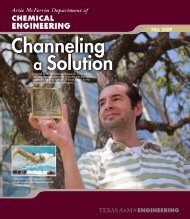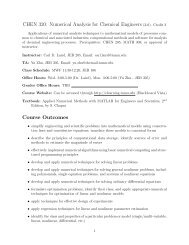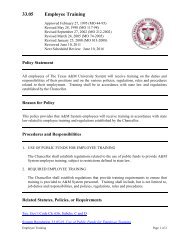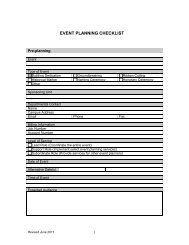SECURITY - Department of Chemical Engineering - Texas A&M ...
SECURITY - Department of Chemical Engineering - Texas A&M ...
SECURITY - Department of Chemical Engineering - Texas A&M ...
Create successful ePaper yourself
Turn your PDF publications into a flip-book with our unique Google optimized e-Paper software.
Business Acumen...from page 1Specifically, automation pr<strong>of</strong>essionals must workto be recognized as business process analysts inlight <strong>of</strong> the growing divide between themselves andproduction and enterprise information technology,Boyes explained.An authority on business-to-businessmarketing with more than 25 years <strong>of</strong> experiencein sales, sales management, marketing andCONTROL Editor-in-Chief Walt Boyes delivers the symposium’s keynote address.product development in the controls andinstrumentation industry, Boyes is widelyconsidered an industry expert.Among the many changes he cited, Boyesunderscored the detrimental effects <strong>of</strong> a gradualbut steady erosion <strong>of</strong> knowledgeable pr<strong>of</strong>essionalsfrom the field. The majority <strong>of</strong> pr<strong>of</strong>essionals whowere adept at running process plants were laid <strong>of</strong>fin the 1980s and ‘90s, Boyes noted. Those thatremained are today retiring in droves, taking theirknowledge with them.“The institutional knowledge they are takingwith them is irreplaceable,” Boyes said.Compounding the problem, the best andbrightest new employees don’t want to work inmanufacturing, many <strong>of</strong> them considering factorywork a less-than-secure career path, he added.Because <strong>of</strong> this phenomenon, processindustry companies are <strong>of</strong>ten unable to hire –even strategically – and, in turn, are relying onvendor companies to supply staff, services andexpertise. These vendor companies however areencountering the same problems in trying toanswer the increased demand for knowledgeablestaff.The ramifications <strong>of</strong> this are already beingfelt on an economic level, Boyes explained.Companies, he said, are changing the way theywork in terms <strong>of</strong> how they’re treating theiremployees. The transition from viewing people assimply replaceable resources to valuable assets iswell under way in the industry. “Companies arestarting to <strong>of</strong>fer more benefits and perks similar towhat occurred in the 1950s, Boyes said.“There are trends that are converging in thenext decade or so that are utterly changing the wayprocess automation is done,” Boyes said. “And asautomation pr<strong>of</strong>essionals, we need to understandthese trends. And if you do understand thesetrends, you can prosper in your career, and thecompanies you work for can prosper as well.”In addition to Boyes’ presentation, severaltechnical papers were presented throughoutthe symposium by a host <strong>of</strong> authorities fromacross the country. Their presentations covereda wide array <strong>of</strong> topics, including metering flowin utilities, compressed air and steam; usingengineering automation s<strong>of</strong>tware to documentsafety instrumented systems; and advanced flowdiagnostics.The symposium also featured approximately50 exhibits, showcased by the leading firms inthe instrumentation and control systems field.The exhibits displayed new and educationalinstrumentation equipment that benefitsmanagers, operators and instrumentationpersonnel.Conference attendees also participatedeach day in various workshops, ranging from adiscussion <strong>of</strong> ethics to flow devices and liquidlevel/ measurement.“We hope we were able to fulfill the expectations<strong>of</strong> all <strong>of</strong> the pr<strong>of</strong>essionals and students whoattended this symposium, through our speakers,presentations, exhibits and workshops,” saidsymposium chairman and senior lecturer JerryBradshaw.Hall’s GTL ProcessResults in IndustryBreakthroughWith the help <strong>of</strong> a <strong>Texas</strong> A&MUniversity chemical engineeringpr<strong>of</strong>essor, a Dallas-based gasto-liquids(GTL) energy firm hasdeveloped what it labels as theindustry’s first commerciallyviable process for convertingnatural gas into useable fuels.Expanding on a processconceived by Kenneth Hall, apr<strong>of</strong>essor in the university’s ArtieMcFerrin <strong>Department</strong> <strong>of</strong> <strong>Chemical</strong><strong>Engineering</strong> and the associatedirector <strong>of</strong> the <strong>Texas</strong> <strong>Engineering</strong>Experiment Station, SynfuelsInternational, Inc., has patenteda method for refining natural gasthat will enable the firm to takeadvantage <strong>of</strong> existing natural gasdepositsThe breakthrough processwas developed in cooperationwith <strong>Texas</strong> A&M and the <strong>Texas</strong><strong>Engineering</strong> Experiment Station.It began when Hall and hiscolleagues were attemptingto develop a method fordisposing <strong>of</strong> lube oil waste in anenvironmentally friendly manner.The Synfuels process focuseson efficient high-temperaturenatural gas conversion intoacetylene, which is thenconverted into ethylene atmoderate pressures andtemperatures. After the ethylenepasses through a catalytic reactor,it is converted into products suchas gasoline and jet fuel.Page 3
STUDENT ACHIEVEMENTS<strong>Department</strong> Recognizes Fall 2007 Graduating ClassThe Artie McFerrin <strong>Department</strong> <strong>of</strong> <strong>Chemical</strong> <strong>Engineering</strong>’s 42 fallgraduates were honored this past December with a reception andawards ceremony in which aselect group <strong>of</strong> outstandingchemical engineeringstudents was recognized.Kristen Gantt, a senior fromAnchorage, Alaska, receivedthe department’s “OutstandingGraduating Senior Fall 2007Award.” Kendra Gil, a seniorfrom Colorado Springs,Colo., received the “<strong>Chemical</strong>Kristen Gantt receives the OutstandingSenior Award.<strong>Engineering</strong> Excellence Fall2007 Senior Award.” AndKiri Kilpatrick, a senior from Carrollton, <strong>Texas</strong>, received the “2007Senior Award” from the RHO Chapter <strong>of</strong> Omega Chi Epsilon,the national honor society for chemical engineering. In addition,Anthony Skach, a senior from Angleton, <strong>Texas</strong>, received his polymerspecialization certification.Addressing the students and their families in attendance, UnocalPr<strong>of</strong>essor and <strong>Department</strong> Head Michael Pishko encouraged thesoon-to-be graduates to stay in touch, reminding them <strong>of</strong> howimportant former students are to the department. “Even thoughyou’re leaving, you’re still a part <strong>of</strong> this department, and we wantto know <strong>of</strong> your triumphs,” Pishko said. Senior Lecturer and Headfor Lower Division Programs John Baldwin, who served as master<strong>of</strong> ceremonies for the event, congratulated the group, saying, “We’regoing to miss you because all <strong>of</strong> us fall in love with all <strong>of</strong> you.You’re the reason we’re here.”Fall 2007 Plant Design Competition Brings out Best in StudentsFor the better part <strong>of</strong> a semester, <strong>Texas</strong> A&M University chemicalengineering students in John Baldwin’s senior-level plant designcourse prepared for the pr<strong>of</strong>essional environment they would soonbe encountering by undertaking a real-world assignment. Theircharge was anything but simple: design a fully functional chemicalprocessing plant for the CelaneseCorporation, a global leader in thechemical manufacturing industry.This past December those studentsunveiled their final designs, and a selectfew received some very real-worldrecognition for their efforts, thanksin part to Celanese, the sponsor andjudge <strong>of</strong> the fall semester “plant designcompetition” - part <strong>of</strong> a capstonecourse in the university’s Artie McFerringas. It’s a task, Baldwin said, that graduates <strong>of</strong> the department arealmost certain to encounter in some form when they enter theirpr<strong>of</strong>essional careers. <strong>Chemical</strong> engineers, Baldwin said, <strong>of</strong>ten playthe role <strong>of</strong> conceptual designers who are typically charged withdesigning entire sequences <strong>of</strong> operations associated with chemicalmanufacturing. Those operations caninclude such processes as distillation,boiling, condensation and othervarious and complex aspects <strong>of</strong> plantproduction. “That’s what it’s all about -to move our students from an academicenvironment to a pr<strong>of</strong>essional engineeringenvironment,” Baldwin said.“Before these students come intoplant design, they are real engineers;they don’t know it. And what you see<strong>Department</strong> <strong>of</strong> <strong>Chemical</strong> <strong>Engineering</strong>.here is the discovery <strong>of</strong> ‘Gee, I can doFirst-place team (left to right): Kristen Gantt, Ryan Deal, CelaneseRyan Deal, Kristen Gantt, Sean Hulseythis!’ You see the light bulbs going on.representative Nathan Powell, Jared Morgan and Sean Hulseyand Jared Morgan were members <strong>of</strong> theThis puts together the project <strong>of</strong> a typicalstudent team awarded first place by Celanese for its original designs <strong>of</strong> engineering environment here in an academic institution.” Divideda methanol-producing industrial plant.into eight teams, each consisting <strong>of</strong> four to five members, Baldwin’sWest and Associates, composed <strong>of</strong> Kyle Gentry, Galen Hauth,students first waded through a 12-page problem statement,Richard Schultheis and Brittaney West was awarded second place, extensively detailing the scenario and the requested outcomes byand S.M.O.W., composed <strong>of</strong> Jesus Mejorada, Matt Olson, Anthony the Celanese Corporation, which uses methanol as a starting pointSkach and Aaron Wilhelm, received third-place honors. Eachfor a number <strong>of</strong> its acetic acid products. The students then spent<strong>of</strong> the winning teams received a monetary prize from Celanese,the semester researching - and in some instances even visiting -and the first-place team also was recognized with a plaquesimilar existing plants. They also picked the brains <strong>of</strong> Celanesecommemorating its achievement. The competition, explained<strong>of</strong>ficials, who made themselves available throughout the project.Baldwin, a senior lecturer and head for lower division programs“The main thing they do is contribute their time and energy toin the department, required students to conceptualize thethe project,” said Baldwin, lauding the corporation’s dedicationcomprehensive organization <strong>of</strong> a process plant - in this scenario, a to the competition and its students. “The monetary awards thatmethanol-producing plant that derives its product from synthetic are given are not nearly as valuable as the time that the companyPage 6
epresentatives contribute to our students.”And that investment can pay <strong>of</strong>f for both student and sponsor,Baldwin said, noting that in some instances student proposals areincorporated by the sponsor into its future plant designs. “You’veheard the saying about thinking outside <strong>of</strong> the box - these studentsdon’t know where the box is, so they’re always thinking outside <strong>of</strong> thebox,” Baldwin said. “And so frequently they’re coming up with ideasand suggestions that working engineers might not come up with.”<strong>Chemical</strong> <strong>Engineering</strong> Students Recognized at‘Chem-E-Car’ CompetitionAggie ingenuity was on display this past March at the 2008American Institute <strong>of</strong> <strong>Chemical</strong> Engineers (AIChE) Regional StudentConference, where two student teams from <strong>Texas</strong> A&M Universityreceived recognition for their designs <strong>of</strong> a chemical-powered vehicle.Participating in the conference’s annual “Chem-E-Car” competition,one Aggie team received top honors in the poster portion <strong>of</strong> the event,and another team placed second. That same team also placed second inthe car performance portion <strong>of</strong> the competition.The first-place poster competition team was composed <strong>of</strong>students Carla Beutlich, Patrick Breckon, Mark Deimund, IanaIacob, Felipe Rendon and Sahiba Singh. As part <strong>of</strong> their entry, theywere required to describe the chemical process that powered theirvehicle. That process was based on generating the necessary voltageand current by using solar panels to enhance the reaction found inglowsticks that results in their chemiluminescence.“It drew interest because it was a different approach to theproject,” said Victor Ugaz, assistant pr<strong>of</strong>essor in the Artie McFerrin<strong>Department</strong> <strong>of</strong> <strong>Chemical</strong> <strong>Engineering</strong>. Ugaz serves as an adviser tothe students participating in the competition.The second-place poster andperformance team consisted <strong>of</strong>team members Daniel Arnold,Michael Landoll, Derek Nelson,Stephen Pope and NeilRodrigues. In the performanceportion, students were requiredto submit a small team-designedvehicle that utilized a chemicalreaction to travel adesignated distanceand stop, allwhile carryinga specifiedcargo.Teamswereinformed <strong>of</strong> the specific distance and payload shortly before the start<strong>of</strong> the competition, forcing them to make the correct calculations andadjustments only moments before the event began.Rodrigues, a junior chemical engineering major from Goa,India, estimated he and his team spent the better part <strong>of</strong> a monthdesigning their entry. Their vehicle, he explained, utilized a pressurevessel concept in which a chemical reaction produces gas thatbuilds pressure in a tank. That pressure serves to turn the motor,powering the vehicle.His team’s second-place finish in the performance portion <strong>of</strong>the event guaranteed it the right to advance to this fall’s nationalcompetition, held at the 2008 AIChE Annual Meeting in Philadelphia.“I enjoy it; it gives me a chance to apply principles from classin a creative way,” said Rodrigues, who has participated in thecompetition multiple times. “It definitely challenges you, creatively.“The team component helps lead you in the right directionwhen you start competing in this event, and then it carries forward.Now, as a junior, I am helping lead the less experienced memberson our team.”Last year, Lale Yurttas, senior lecturer, and Ugaz established aone-hour course in the department to formalize the work <strong>of</strong> thestudent participants. Prior to that, preparation for the competitionwas entirely extracurricular and undertaken as part <strong>of</strong> the university’sAIChE student chapter. Now Yurttas and Ugaz oversee the course andserve as advisers to the student teams. The course aims to introducestudents to all phases <strong>of</strong> engineering design early in their academiccareers and is open to all students, freshmen to seniors. Studentsuse project management tools, learn issues <strong>of</strong> safety, reliability andenvironment, and recognize the importance <strong>of</strong> working in teams.“For the past two years, the Chem-E-Car competitions havegiven students a sense <strong>of</strong> excitement and accomplishment, afeeling shared by both Dr. Ugaz and myself,” Yurttas said.Ugaz agreed, underscoring the quality <strong>of</strong> the students’ work.“Even knowing the quality <strong>of</strong> our students, it’s stillsurprising to see these teams develop such originalideas and then apply the skills they’re learning inclass to a complex project like this,” Ugaz said.
FACULTY NEWSCagin Delivers Keynote Address at InternationalConference in HawaiiTahir Cagin, pr<strong>of</strong>essor in the Artie McFerrin <strong>Department</strong> <strong>of</strong> <strong>Chemical</strong> <strong>Engineering</strong> discussed his research inMarch at the International Conference on Computational and Experimental <strong>Engineering</strong> and Sciences in Honolulu,Hawaii. Cagin’s address, “Modeling and Design <strong>of</strong> Polymeric Architectures for <strong>Chemical</strong> Sensing,” was a featuredpresentation at the week-long conference, which was aimed at bringing together researchers from the world’sacademia, industry and governments to discuss the recent advances in computational and experimental engineeringand sciences and to facilitate collaborative research efforts.Seminario Chosen to Participate inARO Formulation MeetingJorge Seminario, pr<strong>of</strong>essor in the Artie McFerrin <strong>Department</strong> <strong>of</strong> <strong>Chemical</strong> <strong>Engineering</strong>, was one <strong>of</strong> twopr<strong>of</strong>essors from <strong>Texas</strong> A&M University’s Dwight Look College <strong>of</strong> <strong>Engineering</strong> recently selected to participatein a special meeting <strong>of</strong> the U.S. Army Research Office (ARO). The “Program Formulation Meeting for Bio-Molecular Electronics” was conducted by the ARO’s Division <strong>of</strong> Electronics. Also attending the meeting withSeminario was Laszlo Kish, pr<strong>of</strong>essor in the <strong>Department</strong> <strong>of</strong> Electrical and Computer <strong>Engineering</strong>. Seminarioand Kish are members <strong>of</strong> a cadre <strong>of</strong> technical experts who will provide guidance and suggestions to theDivision <strong>of</strong> Electronics as it works to develop a new program in bio-molecular electronics. Members <strong>of</strong> thegroup were selected by the ARO based on their expertise in the highly technical field.Shantz Appointed to Neely FellowshipDaniel Shantz, associate pr<strong>of</strong>essor in the Artie McFerrin <strong>Department</strong> <strong>of</strong> <strong>Chemical</strong><strong>Engineering</strong>, has been appointed holder <strong>of</strong> the William and Ruth Neely Faculty Fellowshipin <strong>Chemical</strong> <strong>Engineering</strong>. The appointment is for a three-year period, effective March 1. Shantzjoined <strong>Texas</strong> A&M University in 2001. He serves as the associate head for graduate programs inthe department. His research focuses on materials development for emerging areas in energy.Since joining <strong>Texas</strong> A&M, Shantz has received more than $2 million in funding, which includessix National Science Foundation (NSF) grants.Hahn Appointed External Examiner byU.K. UniversityJuergen Hahn, assistant pr<strong>of</strong>essor in the Artie McFerrin <strong>Department</strong> <strong>of</strong> <strong>Chemical</strong> <strong>Engineering</strong>,has been appointed external examiner at Queens University in Belfast, Northern Ireland. As anexternal examiner, Hahn will travel to the United Kingdom to review the work <strong>of</strong> a Ph.D. candidate,enrolled at Queens University, who has prepared a dissertation related to Hahn’s field <strong>of</strong> expertise.Contrary to the U.S. higher education system in which a Ph.D. review committee typically consists<strong>of</strong> only faculty members from the candidate’s university, the U.K. system relies on an externalexaminer to make the final determination <strong>of</strong> a student’s progress and competency before conferringdegrees. The purpose <strong>of</strong> the system is to ensure that standards are kept the same across universities and to provide an assurance<strong>of</strong> fair play, given that internal examiners might be biased for or against a candidate.Page 8
American <strong>Chemical</strong> Society Recognizes M. Hahnas ‘Rising Star’Mariah Hahn, assistant pr<strong>of</strong>essor in the Artie McFerrin <strong>Department</strong> <strong>of</strong> <strong>Chemical</strong> <strong>Engineering</strong>, has receivedthe American <strong>Chemical</strong> Society’s PROGRESS/Dreyfus Lectureship Award in recognition <strong>of</strong> her researchcontributions in the areas <strong>of</strong> s<strong>of</strong>t tissue engineering. The award, which is bestowed upon an individual identifiedas a “rising star” by the American <strong>Chemical</strong> Society, goes directly to a female faculty member in the chemical sciencesand engineering fields. As part <strong>of</strong> the award, Hahn will receive a grant that supports travel to one or moreCarnegie Research Universities <strong>of</strong> her choosing, enabling her to give a technical presentation to the facultyand students at the selected institutions. The award is funded by the Camille and Henry Dreyfus FoundationSpecial Grant Program in the <strong>Chemical</strong> Sciences and is designed to promote the full participation andadvancement <strong>of</strong> top women chemists and chemical engineers.Ugaz Honored for Outstanding TeachingVictor Ugaz, assistant pr<strong>of</strong>essor and associate head for undergraduate programs, has been recognizedwith the 2007 Celanese Teaching Excellence Award for his dedication and outstanding contributions to theeducation and pr<strong>of</strong>essional development <strong>of</strong> chemical engineering students at <strong>Texas</strong> A&M. “It’s an honor toreceive this award because it’s chosen by the students; that’s what’s important to me,” Ugaz said. “Withteaching you have something that you can go to every day, and it is always rewarding,” he added.“The young people have a lot <strong>of</strong> energy, and you can really draw from that.”In addition to his teaching responsibilities, Ugaz conducts research focusing on harnessingthe unique characteristics <strong>of</strong> transport and flow at the microscale to enable development <strong>of</strong>advanced DNA analysis technologies. Celanese Corporation, which is based in Dallas andemploys approximately 8,900 employees worldwide, is a global leader in the chemicals industry. The company, whichhas a history <strong>of</strong> supporting chemical engineering education at <strong>Texas</strong> A&M, manufactures acetyl products, including aceticacid, vinyl acetate monomer and polyacetal products and is a world leader in the production <strong>of</strong> high-performanceengineered polymers used in consumer and industrial products.Laird Lends Knowledge to Anti-Terror EffortCarl Laird, assistant pr<strong>of</strong>essor in the Artie McFerrin <strong>Department</strong> <strong>of</strong> <strong>Chemical</strong> <strong>Engineering</strong>,recently participated in an effort aimed at identifying key research areas that could improve thenation’s capabilities for countering terrorist attacks that utilize improvised explosive devices(IEDs). Laird was one <strong>of</strong> a select group <strong>of</strong> experts brought together at a National Academiesworkshop held in Washington, D.C. and sponsored by the Office <strong>of</strong> Naval Research and the NationalResearch Council. The workshop assembled leading thinkers from a variety <strong>of</strong> areas, includinggraph theory, criminology, statistics, data fusion, pattern recognition, law enforcement and discretemathematics.IEDs are destructive devices that can be assembled relatively easily and are difficult to detector prohibit. However, because there are generally many individuals and activities associated with the deployment <strong>of</strong> thesedevices, prediction <strong>of</strong> IED-related activities from intelligence data, including visual, electronic, transactional, narratives andother data forms has been identified as a key element in countering the IED threat. Laird’s research focuses on large-scalenonlinear optimization, parameter estimation, and parallel computing. As part <strong>of</strong> his past research, Laird has worked ondeveloping algorithms as part <strong>of</strong> an early warning contaminant detection system in municipal drinking water networks. Inaddition, he is involved in the modeling and optimization <strong>of</strong> infectious diseases, working to determine the fundamentaldriving forces affecting the spread <strong>of</strong> infectious disease in both time and space.Page 9
Spotlighton GivingIn this issue we recognize donors <strong>of</strong> endowedchairs and pr<strong>of</strong>essorships within the department.Mike O’Connor Chair I in <strong>Chemical</strong> <strong>Engineering</strong>T. Michael O’Connor, Communities Foundation <strong>of</strong> <strong>Texas</strong>, Inc.Mike O’Connor Chair II in <strong>Chemical</strong> <strong>Engineering</strong>T. Michael O’Connor, Communities Foundation <strong>of</strong> <strong>Texas</strong>, Inc.Ray B. Nesbitt Endowment for Faculty Excellence in <strong>Chemical</strong> <strong>Engineering</strong>Ray B. Nesbitt ‘55Charles D. Holland ‘53 Pr<strong>of</strong>essorship in <strong>Chemical</strong> <strong>Engineering</strong>Friends and Former StudentsGas Processors Suppliers Association Pr<strong>of</strong>essorship in <strong>Chemical</strong> <strong>Engineering</strong>Gas Processors Suppliers Association <strong>of</strong> Tulsa, OklahomaMcFerrin Pr<strong>of</strong>essorship in <strong>Chemical</strong> <strong>Engineering</strong>Arthur R. McFerrin Jr. ‘65 and Jeffrey L. McFerrin ‘92Lanatter and Herbert Fox Pr<strong>of</strong>essorship in <strong>Chemical</strong> <strong>Engineering</strong>Lanatter and Herb A. Fox ‘56Dow <strong>Chemical</strong> Company Pr<strong>of</strong>essorship in <strong>Chemical</strong> <strong>Engineering</strong>Dow <strong>Chemical</strong> CompanyKenneth R. Hall Pr<strong>of</strong>essorship in <strong>Chemical</strong> <strong>Engineering</strong>Gas Processors Suppliers Association <strong>of</strong> Tulsa, OklahomaJoe M. Nesbitt Pr<strong>of</strong>essorship in <strong>Chemical</strong> <strong>Engineering</strong>Ray B. Nesbitt ‘55William and Ruth Neely Faculty Fellowship in <strong>Chemical</strong> <strong>Engineering</strong>Ruth M. and William J. Neely ‘52Giving Fact: The Artie McFerrin <strong>Department</strong> <strong>of</strong> <strong>Chemical</strong> <strong>Engineering</strong> was namedin honor <strong>of</strong> Arthur “Artie” McFerrin, Jr., a 1965 graduate <strong>of</strong> the department whoin 2005 committed $10 million to establish an endowed fund to support chemicalengineering at <strong>Texas</strong> A&M.Page 10
Corporate Support for AcademicYear 2006-2007Acutech Consulting GroupAir Products and <strong>Chemical</strong>s, IncorporatedAker Kvaerner Inc.Ammons Law Firm LLP, theApplied MaterialsBP Foundation, IncorporatedChevron Phillips <strong>Chemical</strong> CompanyChevronTexacoCitgo Petroleum CorporationCommunities Foundation <strong>of</strong> <strong>Texas</strong>, Inc.ConocoPhillipsDow <strong>Chemical</strong> FoundationEarly Consulting LCEmerson Technical Analysis LLCExxon Mobil CorporationThe Gas Processors Association <strong>of</strong> HoustonIomosaic CorporationMarathon Oil CompanyPerry & Hass LLPPhilip Morris USA Inc.RMT, Inc.Shell International Exploration and Production Incorporated Deepwater ServicesSis-Tech Solutions LPUOP LLCIndividual Gifts to the <strong>Department</strong> for 2007Mr. James W. Alexander ’47Dr. and Mrs. Rayford AnthonyDr. Dragomir BukurMr. Paul F. Deisler, Jr.Mr. and Mrs. Rudy T. Dismuke ’78Mr. and Mrs. Victor H. EdwardsMr. Nicholas E. Gallopoulos ’57Mr. Jeff D. Gamble ’94Mr. Kerry L. Giese ’76Mrs. Kathy D. GieseMr. Russell A. HallDr. and Mrs. Jack R. Hopper ’59Mr. and Mrs. Nir KerenMr. Trevor Asher KletzDr. and Mrs. James F. Mathis ’46Dr. and Mrs. Michael L. McGuire ’60Mr. and Mrs. MelhemMr. and Mrs. Kendall A. Miller ’88Mr. and Mrs. Nancy M. and Brock D. Nelson ’90Mr. Thomas N. Novosad, III ’96Mr. and Mrs. Jack O. PhilleyDr. Sanjeev R. SarajDr. and Mrs. Norman J. Tetlow ’66Ms. Geneva C. Whitney ’04Page 11
<strong>Texas</strong> A&M University3122 TAMUCollege Station, TX 77843-3122NONPROFIT ORG.U.S. POSTAGEPAIDCOLLEGE STATION,TEXAS 77843PERMIT NO.215GIFT INFORMATIONArtie McFerrin <strong>Department</strong> <strong>of</strong> <strong>Chemical</strong> <strong>Engineering</strong><strong>Chemical</strong> <strong>Engineering</strong> Endowed FundDONOR INFORMATION (Please Print)Name<strong>Texas</strong> A&M Class Yr(if applicable)AddressEmailPhone:PAYMENT INFORMATIONEnclosedContribution$Please make checks payable to TEXAS A&M FOUNDATION.On the check memo line, indicate <strong>Chemical</strong> <strong>Engineering</strong> Endowed Fund.Return to:<strong>Texas</strong> A&M Foundation401 George Bush DriveCollege Station, TX 77840-2811


